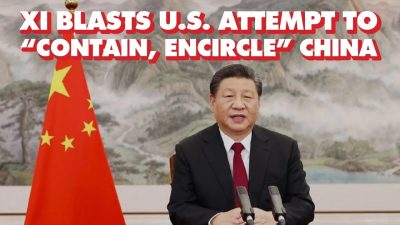The Real Reason Why The Fed Isn’t Cutting Interest Rates
by Brandon Smith, Alt Market:

In an article published in September 2015 titled ‘The Real Reason Why The Fed Will Raise Interest Rates’ I outlined a kind of economic war game, a predictive theory in which the Federal Reserve would hike rates into clear economic weakness in order to deliberately cause the implosion of the vast financial bubble they had created through several years of quantitative easing. At that time this theory received a lot of opposition. Nearly everyone in the mainstream and in the alternative media argued that the Fed was going to shift to NIRP (negative interest rates), in order to continue propping up the system. The idea that the Fed would actually raise rates and cause an engineered crash after propping up the system for so long was treated as outlandish.
Of course, this is exactly what happened. Within a year the Fed had started to tighten policy instead of extending stimulus measures. The denial that this was happening was so strong that many analysts claimed the Fed was simply “pretending” to tighten when they were actually still stimulating. Yet, this claim turned out to be incorrect; nearly every sector of the economy began an immediate and steep decline the moment the Fed launched interest rate hikes and cut its balance sheet. The evidence was mounting that yes, the central bank was not just pretending to tighten – it was actually strangling liquidity and the mirage of economic recovery was quickly fading.
To this day and despite all the evidence to the contrary some people still argue that the fed is either not tightening, or will reverse on tightening measures very soon. In fact, every month since last November there has been a chorus of voices saying that “this is the month” that the Fed will return to easing and possibly QE4. And, every month they have been wrong. This includes this past month of June, when so many people were so certain that a Fed interest rate cut was baked into the cake.
In my article ‘The Federal Reserve’s Controlled Demolition Of The Economy Is Almost Complete’, published in March, I predicted that the Fed would continue to hold interest rates steady for many months to come and that Fed language of “accommodation” and “patience” was a head-fake to keep the investment world tied up in stock markets as every other major indicator showed a recession was upon us. Again, this is exactly what has happened.
Once the Fed raised rates to their neutral rate of inflation (something they had not done for decades) the fate of the US economy was sealed. To be fair, the real rate of inflation is much higher than the Fed admits, but the point remains that the US economy as it stands today cannot handle even moderately higher rates. With corporate and consumer debt at historic highs not seen since 2007 just before the credit crash, any interest pressure above zero is going to destroy the fragile economic bubble.
Some people claim that the Fed is completely unaware of this situation and is fumbling in the dark. But this is not true. In 2012 Jerome Powell outlined exactly what would happen if the Fed began tightening policy in the October minutes of the Fed meeting. Powell KNEW that higher rates and balance sheet cuts would cause the kind of crash which is now happening; but as soon as he became the Fed chair in 2018 he launched tightening measures anyway.
Whether you are for or against Fed tightening measures is truly meaningless. The point remains that the Fed created the Everything Bubble, and now they are crashing the Everything Bubble and they know they are doing it.
So, where do we go from here? Has the Fed done all the damage it needs to do to ensure a crash? Is all this talk of accommodation actually real this time? Will they cut interest rates soon in order to prop up the system longer. I continue to predict the Fed will not be cutting interest rates or ending balance sheet cuts until there is a blatant breakdown, or a major distraction event. And by “breakdown” I am referring to public perception of the economy waking up to the reality of the crash.
It is important to remember that the US economy has been in negative territory for the past 10 years. It has been hanging by three thin threads – the first being Fed stimulus (which has now been taken away – sorry skeptics but this is a fact), the second being the dollar’s world reserve status, and the third being public perception of recovery. The central bankers are now relying heavily on the manipulation of public perception in order to keep certain sectors (like stock markets) afloat for a little while longer. What is the specific goal in this? It’s hard to say. However, the move to trick the investment community into making far reaching assumptions has some advantages.
Stock markets are absolutely useless as an economic indicator because they lag far behind real financial conditions. Stocks fall after every other fundamental indicator has already turned negative and the crash is already at the public’s doorstep. However, they do serve one purpose; stock prices can be exploited to give the population a false sense of economic health, leaving them unprepared and vulnerable to the consequences of a downturn. Most Americans do not track economic data beyond stocks and employment, which are both highly manipulated points of reference.
Stocks remain levitated on two factors: Massive stimulus from China since December, and blind hope from the investment world that the Fed is going to bring back the punch bowl and pump out stimulus again. Minor language changes to Fed statements are now hyped as dominant indicators that the Fed is about to flood the markets with liquidity; yet other language indicators showing the opposite are ignored. With so much capital lured into stocks on the “certainty” of Fed rate cuts or stimulus – I ask, what would happen if the Fed DOES NOT fulfill growing market expectations?
On June 19th just after the Fed meeting I noted that there was little chance of of a rate cut in July, and recent statements from Powell and St. Louis Fed President James Bullard support this argument.
After the June meeting, many in the investment world priced in a 100% chance of an interest rate cut in July. Why did they do this after being wrong every month for the past several months? I still can’t figure out what the source of this assumption is. Nowhere in the Fed’s minutes or in post meeting statements has the Fed indicated a cut in July. The reality is that the last Fed meeting showed NO CUTS until the end of 2020. This does not necessarily mean the Fed will hold rates until that time, but there is no evidence to support the notion that they will cut in July.
Perhaps I am wrong and the Fed will follow assumptions this time instead of assumptions following the Fed. I haven’t been wrong on Fed policy changes yet, but my point is, there is no evidence that they will cut next month, only expectation based on hearsay.
The Fed continues to lie about economic expansion, claiming a strong recovery or improving fundamentals when all the data shows economic decline; from bond yields to housing sales to housing prices to auto markets to manufacturing to shipping and freight to retail closures to weakening job prints, etc. At the same time we are witnessing inflationary pressures in necessities like food, fuel and rental housing. It’s a stagflationary mess.
Incessant reporting of strong economic health and the defiant dismissal of declines is not the behavior of a Fed that is about to capitulate on tightening. Yet, the investment community has been all-in on a rate cut for months. When the rate cuts don’t come, they then assume that the past month was close, and that the next month is a sure thing. It’s truly bizarre.
As long as the Fed holds rates near the neutral rate of inflation and continues to cut assets from its balance sheet, flooding the economy with treasuries, mortgage backed securities and toxic assets, the decline of multiple sectors is assured. There may come a point in which the Fed has done all the damage it needs to do to accelerate the crash, allowing them to then pull back on tightening, but we have not reached that point yet. As I have noted in past articles, the Fed has done all this before.
Loading...



